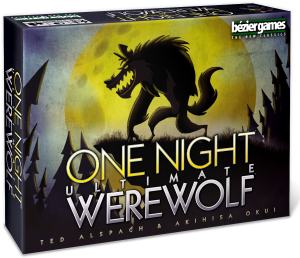Tabletop Game Review: One Night Ultimate Werewolf
As a tabletop gamer, you haven’t lived until you’ve watched your friends spiral into a paranoid breakdown and start aggressively pointing fingers at one another like it’s the end of Reservoir Dogs. Nothing beats the feeling of barely contained glee when you see everyone’s suspicions descend on the wrong person, all because your Machiavellian machinations subtly nudged them in that direction. This is the magic of One Night Ultimate Werewolf.

What Kind of Game Is It?
One Night Ultimate Werewolf is your classic social deduction/bluff game: players are either on the Villager team or the Werewolf team, and the Villagers want to figure out who’s a Werewolf. Werewolves, meanwhile, want to stay hidden and lie about who they are. At the end of the game, everyone votes on a person to accuse of being a Werewolf, and the person who gets the most votes has their role card is flipped over. In-game, this represents the accused being killed by the angry mob of Villagers.
If the accused really was a Werewolf, the Villagers win (yay)! If they’re actually a Villager, the Werewolves win and the Villagers have to live the rest of their lives plagued with doubt and guilt over killing an innocent person (not really). Games usually take about ten minutes, including five minutes of deliberation and discussion. At the end of the five minutes, people have to pick someone to accuse.

What’s The Gameplay Like?
The game is pretty simple: everyone is given a random role card face-down, and three more are placed in the center of the table. Everyone knows what roles are included in the game, but no one knows which ones are in the middle and which ones are in the hands of other players. People look at their own cards, then everyone closes their eyes for the “night” phase.
If you have the One Night Ultimate Werewolf app (highly recommended), your phone will call each of the roles and tell them to ‘wake up’ (open their eyes) and perform their action. Each role card has a unique action, like the Seer, who can look at another player’s card or two cards in the middle, or the Robber, who gets to look at another player’s card and then swap with them. Werewolves, meanwhile, wake up and look at each other to see who’s on their side. If there’s only one werewolf, they get to look at a card in the middle. Since Werewolves don’t have abilities, they have to rely on their wits.
Once everyone has done their action, everybody wakes up and the five-minute deliberation phase begins. This is where the chaos starts, because anybody can lie about who they are, what they did during the night phase, or what they know. Alternatively, you can choose to say nothing at all. Either way, it’s up to the Villagers to figure out the truth.
What Makes It So Fun?
There are few things more satisfying than successfully fooling all your friends as a Werewolf or, alternatively, perfectly deducing everyone’s role and catching a crafty Werewolf friend in a contradiction. The game ends up being something like a courtroom drama, complete with people shouting “ARE YOU THE WEREWOLF? I WANT THE TRUTH!”

Trying to win this game based solely on evidence and logic only takes you so far, so the more comfortable you are with reading friends and playing off peoples’ emotions the better time you’ll have.
For example: everyone is ganging up on your friend Nic for refusing to tell people what his role is, but he says it’s because he wants to catch a Werewolf out in a lie. Is Nic really a werewolf, biding his time so he can create a better alibi, or is he really a Seer who’s waiting for a Werewolf to claim to be a role card that’s actually in the center of the table? You notice that your friend Ricky keeps trying to steer accusations toward Nic, almost like he’s desperate to point suspicion away from himself…maybe Ricky is the real Werewolf…
There’s always a human element to the game, and the fun lies in balancing sound logic with intuition. Emotions will run high, trusts will be broken, lies will be told, and in the end you’ll learn how well you really know your friends.
PROS AND CONS:
PROS: One Night Ultimate Werewolf is a great party game for large groups—it’s easy to learn, simple to set up, fast to play, and pretty intuitive. At heart, this is a game about manipulating your friends and playing off their personalities, meaning that if you’ve got a good group dynamic, it’ll make the game that much more fun. The variety of roles you can put into each scenario also makes the game customizable to the sorts of playstyles that work for your group. The Daybreak expansion brings a lot of cool (and sometimes complicated) roles to spice up the base set.
CONS: Like a lot of social deduction/bluff games, you always run the risk of having certain people dominating the discussion. In the same vein, this is a game about talking and arguing, and sometimes it’s tough to keep the discussion on track (five minutes is a lot less time than you think). This isn’t a game for thoughtful, strategic players who like to build plans and optimize—they’re going to end up getting blind-sided by the fast-moving and chaotic deliberations. As long as you have a good host to mediate, though, chaos and fun should balance out.
FINAL VERDICT:
This is one of the easiest and lightest tabletop party games around, and it’s a must-have for any collection. Highly recommended.
You can buy it on Bezier Games’ website, on Amazon, or at your local game store.



[…] role” game, where one player is initially the “Thing”. In that way it can be compared to One Night Ultimate Werewolf or other similar card games that have become popular lately, where there is a “villain” among […]